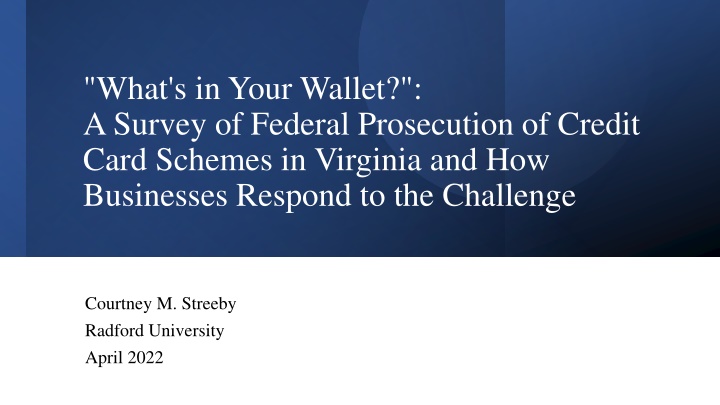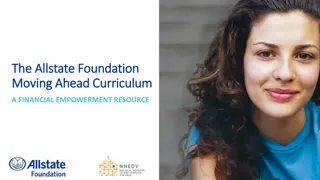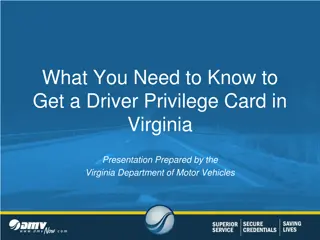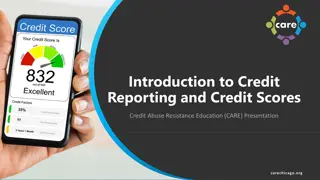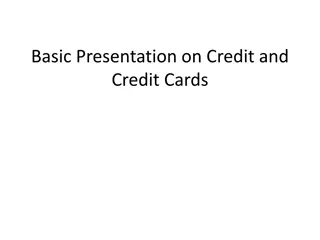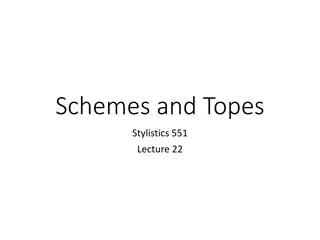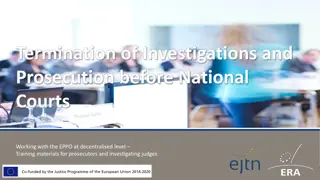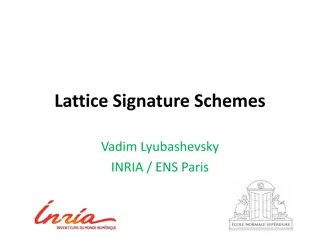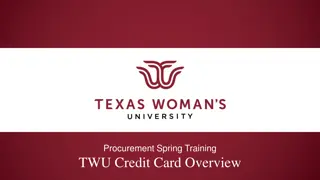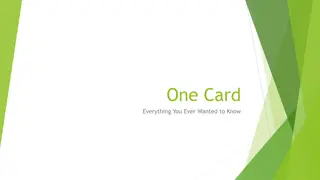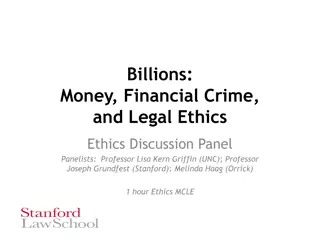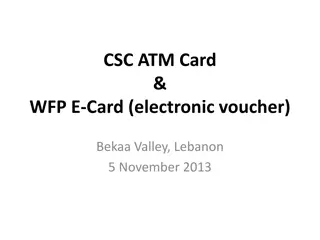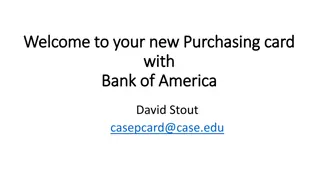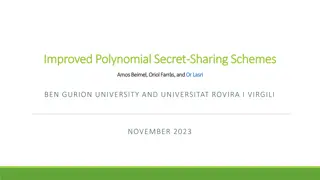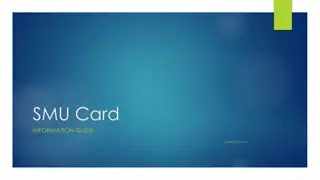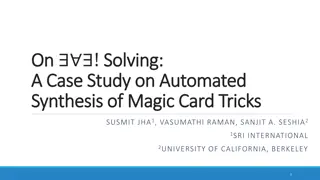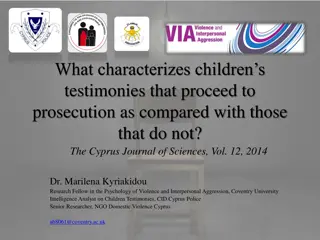Federal Prosecution of Credit Card Schemes in Virginia: Business Responses
Explore the challenges of credit card fraud in Virginia, focusing on federal prosecution, business responses, and common fraud schemes. Investigate detection methods, prevention strategies, and insights from court cases and company interviews.
Download Presentation

Please find below an Image/Link to download the presentation.
The content on the website is provided AS IS for your information and personal use only. It may not be sold, licensed, or shared on other websites without obtaining consent from the author.If you encounter any issues during the download, it is possible that the publisher has removed the file from their server.
You are allowed to download the files provided on this website for personal or commercial use, subject to the condition that they are used lawfully. All files are the property of their respective owners.
The content on the website is provided AS IS for your information and personal use only. It may not be sold, licensed, or shared on other websites without obtaining consent from the author.
E N D
Presentation Transcript
"What's in Your Wallet?": A Survey of Federal Prosecution of Credit Card Schemes in Virginia and How Businesses Respond to the Challenge Courtney M. Streeby Radford University April 2022
Problems of Practice 250,000 case increase of Credit Card Fraud Reports from 2017 to 2020 COVID-19 pandemic hit in early 2020, which increased online transactions 92% of credit card fraud consists of using existing accounts. In Virginia, it is the most reported type of fraud.
How are businesses responding to the challenge of credit card fraud? Do these methods seem to be deterring and detecting fraud well enough for the companies? Research Questions What do federal court cases show about the scheme and how they are caught? Are there commonalities in the schemes reviewed in the federal court cases?
Background o Definition of Credit Card Fraud o "the unauthorized use of a credit or debit card, or similar payment tool...to fraudulently obtain money or property" - Federal Bureau of Investigation o Automated methods for reviewing transactions are the most desirable methods of detecting and deterring credit card fraud o Common methods of detection and prevention o Machine Learning Methods o Artificial Neural Networks o Transaction Window Bagging
Methodology 27 United States District Court cases involving credit card fraud were examined Eastern District and Western District of Virginia 2014 to 2020 8 semi-structured interviews with Virginia-based companies Questions asked: Describe a recent credit card fraud suffered by the company, if any. Describe the primary elements of your company's credit card system integrity program. Describe the major challenges to your company's credit card integrity program. Describe the role of outside vendors in your credit card integrity insurance program. Describe your companies' interactions with trade associations and other industry trade groups in maintaining credit card transactional insurance.
Question 1 5 of the 8 companies suffered from fraud Results from Interviews 3 of 8 used Tokenization 2 of 8 used Machine Learning Techniques 3 of 8 increased Segregation of Duties All used outside vendors Question 2 4 of 8 said staying ahead of the offenders committing the fraud 1 of 8 said skimming devices is what has been difficult for them 1 of 8 said Machine Learning Software is too manual Question 3
Every company used outside vendors Outside Vendors used: BB&T and QuickBooks by Intuit Square NelNet SafeTech Paymentus Corporation Lexus Nexus Question 4 Results from Interviews Continued... 3 of 8 interacted with outside trade groups or organizations Question 5 They would attend conferences and symposiums
Results from Federal Court Cases Scheme Length (Months) Amount of Fraud ($) Sentence (Months) < 40 22 < $100,000 12 20 to 40 8 40 to 60 2 $100,000 to $1,000,000 8 40 to 60 3 > 60 1 > $1,000,000 4 60 to 80 4 Unknown 2 Unknown 3 80 to 100 1 100 to 120 3 > 120 2 Unknown 6
Results from Federal Court Cases Continued... # of Real Person Victims # of Financial Institution Victims # of Non-Financial Institution Victims Sentence ($) < $100,000 13 < 10 10 < 6 22 < 6 25 $100,000 to $1,000,000 5 10 to 100 11 > 6 5 > 6 2 > $1,000,000 3 > 100 6 Unknown 6
Results from Federal Court Cases Continued... # of People Involved New or Existing Accounts Methods Charges < 1 9 New 7 Stealing credit cards/numbers 25 Aggravated Identity Theft 20 1 to 5 12 Existing 15 Work to steal information 3 Conspiracy to Commit Access Device Fraud 5 > 5 6 Both 5 Access Device 10 Bank Fraud 4 Bank Fraud 5 Conspiracy to Commit Wire and Bank Fraud 4 Wire Fraud 4 Conspiracy to Commit Wire Fraud 4 Access Device Fraud 3 Mail Fraud 3
Findings and Conclusion The sentences and fines that are being imposed on the offenders appear insufficient to deter potential fraudsters much less those who are committing credit card fraud. It does not appear that small businesses seem as affected by credit card fraud as the larger corporations are. It appears that most companies are outsourcing these security measures.
Key References Federal Bureau of Investigation (n.d.). Credit Card Fraud. Retrieved November 24, 2021, from https://www.fbi.gov/scams-and-safety/common-scams-and-crimes/credit-card-fraud Federal Trade Commission. (2021). Consumer Sentinel Network Data Book 2020. Federal Trade Commission. Retrieved August 2, 2021, from https://www.ftc.gov/reports/consumer-sentinel-network-data-book-2020. Federal Trade Commission. (2018). Consumer Sentinel Network Data Book 2017. Federal Trade Commission. Retrieved August 2, 2021, from https://www.ftc.gov/policy/reports/policy-reports/commission-staff- reports/consumer-sentinel-network-data-book-2017/main Niu, X., Wang, L., Yang, X. (2019). A Comparison Study of Credit Card Fraud Detection: Supervised versus Unsupervised. ArXiv. https://arxiv.org/abs/1904.10604. Identity Theft Resource Center. (2021). 2020 Annual Report. Identity Theft Resource Center. Retrieved August 2, 2021, from https://www.idtheftcenter.org/wp-content/uploads/2021/03/03.25.2020_2020-Annual- Report_FINAL-optimized.pdf
